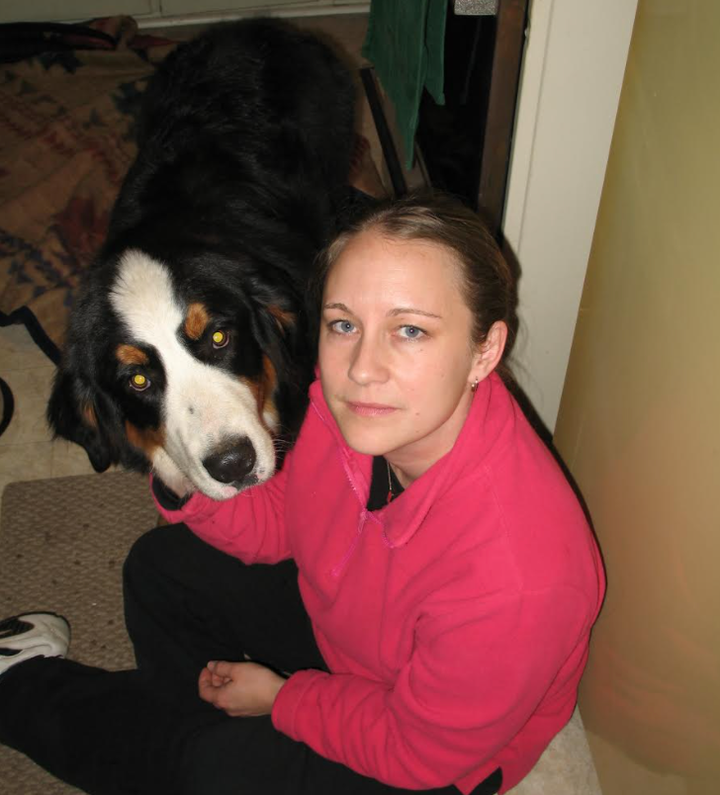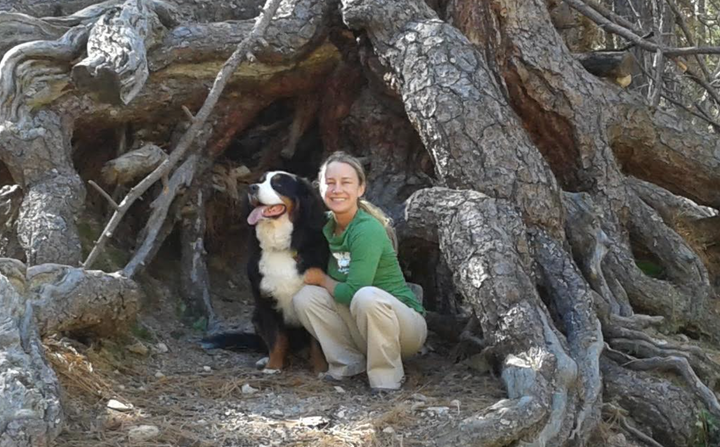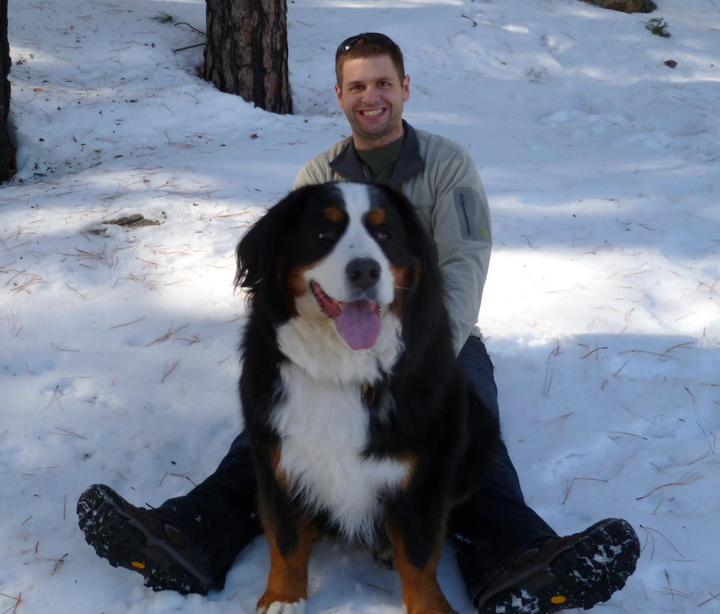
On Christmas Eve three years ago, I sat on my front lawn with my dog Mathilda and watched a Southwestern sunset paint the sky pink and gold. It was the last sunset Mathilda and I would share, the last time we’d sit, pressed together, with her fur warming the skin of my bare leg as the day’s light faded.
A veterinarian from Lap of Love, an in-home euthanasia service for sick animals, would arrive at our door later that evening. I would say goodbye to my friend and companion of the past 10 years in a home barren of seasonal trappings. At the time, I didn’t know if I would survive her passing, or if the deep impulse for self-destruction that her companionship had staved off would again rear its unwelcome head.
As a veterinarian myself, I’ve guided many people through the painful process of losing a pet by letting them know that granting our beloved companions a pain-free death is a valuable act of love and care. I’ve peacefully ended animals’ lives, spending countless hours in exam rooms, on the floors of treatment rooms, or kneeling on blankets next to ailing dogs as I offered comfort to grieving family members. I’ve passed tissues and searched for just the right words that fit the pet and situation.
Often, the words that came to mind were things like: “You gave Cooper a good life.” Or, “I can see you loved her very much.” Or, “This was the right decision.” And most of the time, it was. One of the things I do as a veterinarian is help people to understand when it’s time to let go — before the bad days outnumber the good ones and suffering sets in. I consider it one of my most important duties, both to the animals and to the family members who love them. But when it came to Mathilda, I couldn’t make the compassionate decision to let her go when she was ready, despite my years of training and experience.
I’d said goodbye to my own companion animals in the past, and I’d loved them all, but Mathilda was special. She was a 100-pound Bernese Mountain Dog with a gregarious personality and a love of counter-surfing, and she had been my companion and support through the most difficult time of my life.
I adopted her from a rescue in the Midwest when she was 10 months old. I’d intended to drive out and pick her up, but the rescue sent her to me c.o.d. in the cargo of a plane. When the plane was rerouted and delayed, and no one at the airline could tell me where she was, it was the closest I’d ever come in my life to being forcibly ejected from an airport lobby. To say I was upset and worried would be an understatement.
When she finally arrived, eight hours later than planned, I paid the $250 required to release her from cargo. She was traumatised and covered in excrement, and had been given no food or water for at least 18 hours. Something broke inside me when I first saw her, and I knew I would do anything for this dog. As it turns out, the feeling was mutual.

Several years before our last evening together, Mathilda barrelled through a locked bedroom door and prevented me from killing myself. I was suffering from the uncontrolled symptoms of a mental illness that had not yet been diagnosed, and a string of psychiatrists had switched me on and off various medications that failed to work or in any way relieve my depression. Yet there was nothing on that particular occasion that made me think, Today is the day. No inciting incident, no moment that I can identify as the proverbial last straw. In fact, though I’d thought a lot about ending my life, planned it even, the decision to follow through on that day surprised me. It was made in a moment of epiphany when I realised that not only did I have nothing to strive for, but that there was a complete loss of hope that anything good would ever return to my life. I saw the days ahead as a long, blank corridor, with no exit or end in sight.
I gave Mathilda a big bowl of food, loaded it with her favourite treats, went to the bedroom and locked the door behind me. In that moment, I believed the pain would finally subside.
Just when I was about to end my life, the bedroom door flew open with a crash. I froze. I heard the tap-tap of Mathilda’s toenails on the tile and suddenly she was in front of me, her face nearly level with mine from where I sat on the bed. Normally a very vocal dog, this time she was silent. She just looked at me with so much love and trust. For a second, I nearly continued anyway, even with the dog I’d sworn to protect and care for all her life sitting right in front of me. But I couldn’t do it. I couldn’t leave her.
Mathilda saved my life that day, and she continued to save my life during the difficult months and years that followed after I was eventually diagnosed with major depressive disorder and post-traumatic stress disorder. Mathilda went everywhere with me. During the week, she came with me to the clinic and hung out in my office while I saw appointments. Admittedly, she was not loved by all — once, a veterinary technician left half a pizza in the office, intending to eat it later, only to come back to find the box on the floor in front of a very satisfied Mathilda.
That wasn’t the only incident. Mathilda’s weakness was food, and anything was fair game. While visiting my neighbour, during an unsupervised moment, she stole some eggs off the kitchen counter and managed to carefully break them and eat the yolks while leaving the shells in a neat pile on the carpet. Fortunately, the neighbour was amused and somewhat in awe of her skills. On the weekends, Mathilda and I took long hikes where I’d let her run off leash, confident she’d always return to me.
Even though I knew she was getting older, I never thought about what would happen when she inevitably reached the end of her life. When Mathilda became ill with an aggressive bone cancer that spread rapidly to her lungs, her quality of life quickly declined. I refused to see it. I begged her to keep going for me. I cooked her favourite meals, increased her pain medications and took her to chemotherapy sessions that she hated. I had visions of her impending death where I imagined that I would become catatonic and drop into a state of neither life nor death. I longed for oblivion, and images of self-harm crept into my thoughts. While my neighbours were putting up Christmas trees and decorating their homes with cheerful lights, I lay on the floor with Mathilda, trying not to notice the effort it took her to breathe.

Finally, my husband, Danny, asked me to let him schedule a euthanasia appointment for Mathilda. “Look at her,” he said. “She’s suffering.” Mathilda had moved to lie at his feet, and she gazed up at him with a look of desperation. “She’s ready,” Danny said. “Please let her go.” As if blinders were lifted, I finally saw how little vitality Mathilda had left, after giving so much to me her entire life. She was exhausted, and if I truly loved her, I would say goodbye to her.
Danny called Lap of Love, and Mathilda peacefully took her last breath in our home as I held her. Afterward, I felt as if my chest had been hollowed out, leaving an emptiness that would never be filled. I swallowed a sleeping pill that night, afraid of the ever-present temptation to take more than I needed. We spent Christmas Day in silence, somberly opening presents shipped to us from family members.
There is tremendous pressure to express joy and gratitude during the holidays, but for many like me, this is a season darkened by grief and loss. Losing a pet at this time of year is particularly hard, as the pressures of creating a perfect celebration, and dealing with family interactions, trips and other events, don’t leave much time for grief. As a veterinarian, I’m used to dealing with death and loss around the holiday season. I routinely dreaded the holidays when I worked at an emergency hospital, knowing that I’d be putting more pets to sleep the closer it got to Christmas.
In fact, veterinarians have observed this trend for years. In 2018, a co-founder of Lap of Love told The Boston Globe that euthanasia of companion animals increases by as much as 50% around the Christmas holidays. There are several reasons for this apparent uptick in pet loss. People may be traveling over the holidays and don’t want to leave behind a sick animal who may pass away while they’re gone. Others may be waiting for kids to come home from college to say goodbye to their pets. Animals who are ill or exhibiting behaviour changes, such as urinating in the house, may be difficult to deal with while navigating family visits and holiday responsibilities. Elderly animals may exhibit more pain and symptoms of arthritis as the weather gets colder, leading family members to make quality-of-life decisions. Financial constraints over the holidays may also factor into the decision to let go of an animal companion. Veterinarians are often there for families during these times and become witness to the cracks and stresses created by making these difficult decisions. It is not easy to decide to end a life, nor is it easy to take one, even in compassion.
Dealing with the deaths of pets on a daily basis is one reason for the high suicide rates among veterinarians — twice that of people in the dental and medical professions and four times the rates of the general population. I’m among the 9% of veterinarians who, according to one survey, have attempted suicide. Over the years, I’ve lost several colleagues and friends to suicide — including my friend Christine, who graduated from veterinary school a year ahead of me and with whom I’d shared shifts at a local animal hospital. Each one of these tragic losses reminds me of the tenuousness of life, and how I had nearly lost my own. In the months after Mathilda’s death, I worried I would join these numbers.

Eventually my grief receded to a dull ache rather than a raw, seeping wound, and I realised that letting Mathilda go was an essential step in my own survival. Though I will always regret that I didn’t make the decision to say goodbye sooner, Mathilda gifted me with a will to live that transcended her passing. She helped me understand just how fragile life is — a lesson I needed after coming so close to throwing my own life away.
We hold on to love while we can, but sometimes letting someone go is the greatest expression of that love. Mathilda taught me to survive loss with greater resilience, and her passing gave me a new appreciation for the winter season — not for the holiday celebrations and the shiny lights, but for an older, deeper meaning that harks back to the vegetative death and quietude that winter brings. Twice, Mathilda and I reached the threshold of mortality: once for me when it was not yet my time, and once for her when her passing was natural and right. Now, my winters are spent in stillness and commemoration, for the seasonal darkness that must precede the renewal and regrowth of spring.
Ingrid L. Taylor is a freelance writer, poet and veterinarian whose work has appeared most recently in the Southwest Review, The Ocotillo Review, Sentient Media and elsewhere. You can catch up with her on Instagram at @tildybear and find out more about her work at ingridltaylor.com.
Help and support:
- Mind, open Monday to Friday, 9am-6pm on 0300 123 3393.
- Samaritans offers a listening service which is open 24 hours a day, on 116 123 (UK and ROI - this number is FREE to call and will not appear on your phone bill).
- CALM (the Campaign Against Living Miserably) offer a helpline open 5pm-midnight, 365 days a year, on 0800 58 58 58, and a webchat service.
- The Mix is a free support service for people under 25. Call 0808 808 4994 or email help@themix.org.uk
- Rethink Mental Illness offers practical help through its advice line which can be reached on 0808 801 0525 (Monday to Friday 10am-4pm). More info can be found on rethink.org.